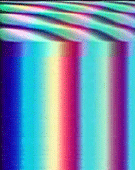
In the 1960s, artists working with video and television had revolution on their mind. As Nam June Paik wrote in the first issue of the publication Radical Software, 'If revolution meant for Russians in 1920s electrification... then the revolution in the 60s means electronicification... mind to mind... planet to planet...' This utopian spirit, this belief that broadcast technology could be used as a tool to affect social change has returned repeatedly in decades since. 'Flipped Chips' is an evening of video curated by prolific artist duo LoVid, to be held at Ocularis, in Brooklyn, tonight. The program pairs early video artists, like Paik, Dan Sandin, and Steina and Woody Vasulka, who built their own audio-visual technologies, with a younger generation of artists doing the same. These include noTendo, Cory Arcangel, Paul Slocum, Karl Klomp, and collective Paper Rad. The juxtaposition highlights a difference in their two respective eras. Unlike the early generation for whom video was entirely new, these younger artists were born with TV and socialized by the net. Variously hacked together or carefully programmed, kitschy or politicized, their works speak to a more enmeshed relationship with mainstream media. Discern the generational difference for yourself: In what form does this group of DIY tech pioneers carry on the early flame of media revolution? - Lauren Cornell

